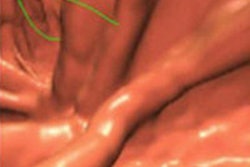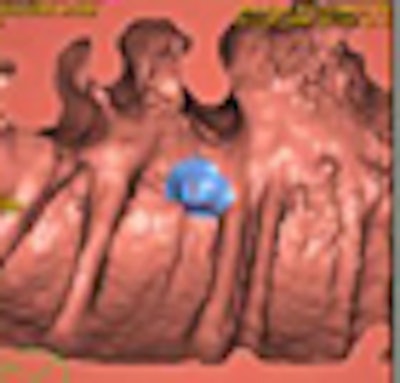
Computer-aided detection (CAD) of colorectal polyps combined with electronic cleansing of tagged data is a promising but technically daunting approach to finding more polyps in virtual colonoscopy (also known as CT colonography or CTC).
In a new study from Seoul, South Korea, electronic cleansing slightly increased the sensitivity of CAD in virtual colonoscopy, but more than doubled the number of false-positive detections. Fortunately, most false positives were easily dismissed by readers.
"The use of fecal tagging and electronic cleansing are both essential elements in the successful performance of CTC, especially for reduced or no bowel preparation," said Dr. Jae Yeon Wi from Seoul National University Hospital at the 2009 European Congress of Radiology (ECR). "However, the integration of these two factors is not as simple as we may expect. This is because the electronic cleansing applied in fecal-tagged CTC datasets creates lots of artifacts, including degradation of soft-tissue structures and pseudopolyp or false fistula information."
A study published last year used electronic cleansing but no CAD. Authors C. Daniel Johnson and colleagues found that artifacts from electronic cleansing (EC) increased sensitivity but slightly decreased specificity (American Journal of Roentgenology, February 2008, Vol. 190:2, pp. 361-366).
For their study, Wi, Dr. Se Hyung Kim, and colleagues compared the performance of a dedicated CAD system (CAR version 3.5.2, Philips Healthcare, Andover, MA) with and without the use of electronic cleansing in a population at elevated risk of colorectal cancer.
The rigorous cleansing and tagging protocols used both cathartic cleansing (magnesium citrate plus 20 mg bisacodyl laxative) and barium fecal tagging (60 mL of 40% barium suspension in 19 patients; 600 mL of 4.6% barium suspension in 13 patients), as well as 50 mL of gastrografin iodinated oral contrast agent.
The study included 33 patients (22 men, 11 women; mean age, 58.2 years) suspected of having colonic polyps detected by previous diagnostic colonoscopy or sigmoidoscopy and scheduled for colonoscopic polypectomy. In 25/33 cases, the colonoscopy or sigmoidoscopy was performed for screening purposes.
Automated CO2 insufflation (ProtoCO2L, Bracco Diagnostics, Princeton, NJ) was used before scanning in prone and supine positions on a 64-detector-row scanner (Brilliance 64, Philips Healthcare). The low-dose exams were acquired using 0.625-mm detector collimation, 1-mm slice thickness, 120 kVp, and 50 effective mAs.
Within six hours of VC, conventional colonoscopy was performed by an experienced gastroenterologist who administered an additional 2L of polyethylene glycol solution, Wi said. Segmental unblinding with VC data was used to determine the results, and all resected polyps were sent for histologic examination.
The researchers analyzed per-polyp sensitivities according to polyp size threshold (less than 6 mm, 6 to 9.9 mm, and 10 mm and larger), and the average number of false positives was calculated both with and without the use of EC, using optical colonoscopy as a reference standard.
Finally, the causes of false negatives and false positives were analyzed, and the distribution of the causes of false positives and false negatives were statistically compared with and without EC using Fisher's exact test.
The results showed 82 pathologically proven polyps (54 < 6 mm; 16 from 6-9.9 mm; 16 ≥ 10 mm): 14 flat, 57 sessile, and 15 pedunculated. Of the 82, 61 were adenomatous, seven were hyperplastic, three were cancer, and 11 were "other," Wi said. Three patients had no polyps.
"The per-polyp sensitivity of CAD for polyps 6 mm or greater in size was 84% without EC and 94% with EC," Wi said. "Electronic cleansing showed a tendency toward higher per-polyp sensitivities regardless of size threshold; however, the difference was not statistically significant."
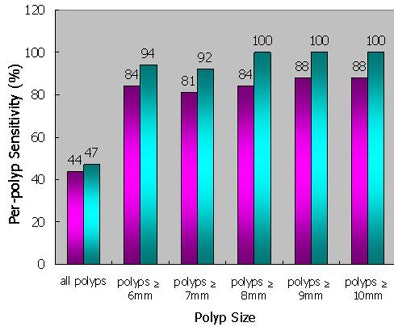 |
| The per-polyp sensitivity of CAD for polyps ≥ 6 mm was 84% without electronic cleansing (magenta bars) and 94% with electronic cleansing (teal bars). The use of electronic cleansing showed a tendency toward higher per-polyp sensitivity regardless of size; however, the difference was not statistically significant. All images courtesy of Dr. Jae Yeon Wi. |
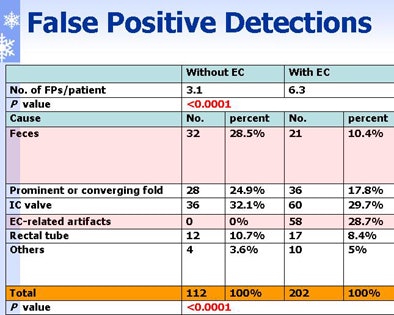 |
| The number of false positives, as well as the distribution of causes for false-positive CAD detections, differed significantly before and after electronic cleansing. |
"Among 32 polyps larger than or equal to 6 mm, five polyps were missed by CAD without EC, while only two polyps were missed when EC was applied," Wi said.
Limitations of the study included the small cohort and the use of a single CAD scheme that was not optimized for use with electronic cleansing, Wi said. More studies are needed to compare the effect of other colon CAD systems in a larger patient cohort -- and with a gentler cleansing protocol.
In addition, some artifacts that led to false positives in the present study have been addressed in earlier research efforts, including the suppression of hyperattenuation surrounding tagged VC data, and the preservation of soft tissues in tagged, electronically cleansed datasets.
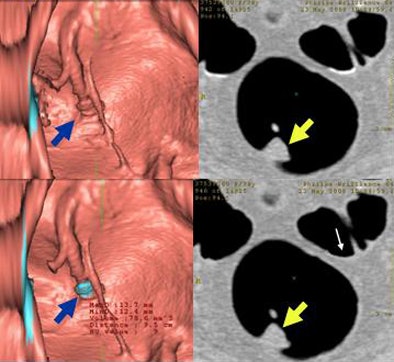 |
| Without electronic cleansing, a 10-mm polyp was missed by CAD due to its flat morphology (top row above). After electronic cleansing was applied, CAD successfully detected this polyp (bottom row above). The lesion was confirmed as a well-differentiated adenocarcinoma on pathologic examination (below). |
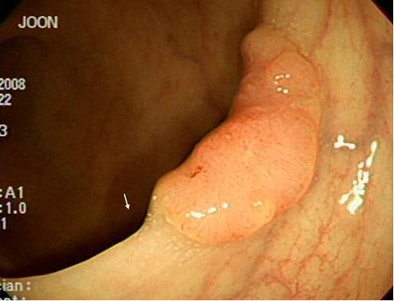 |
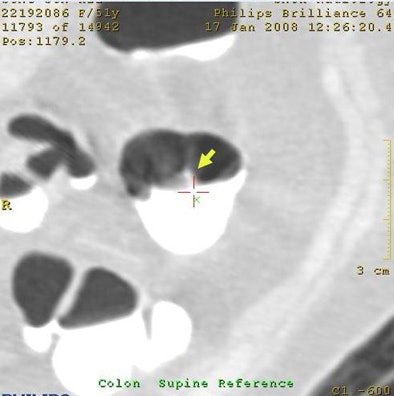 |
| Electronic cleansing artifacts caused false positives resulting from untagged feces, pseudoenhancement of tagged materials (above), and air-contrast-wall interface (below). |
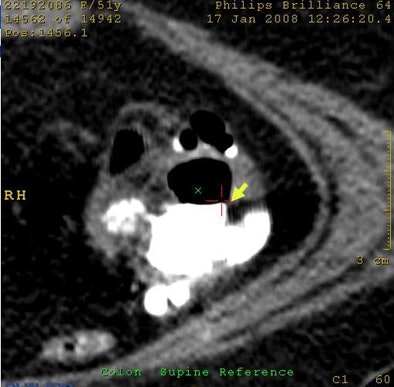 |
"Comparable per-polyp sensitivity can be achieved when Philips CAD is used with EC as compared to without EC, Wi concluded. "However, the significantly larger number of false positives with electronic cleansing, mainly due to EC-related artifacts, remain to be improved."
By Eric Barnes
AuntMinnie.com staff writer
April 10, 2009
Related Reading
Virtual colonoscopy beginners do better with 3D data, February 5, 2009
Dual-energy VC makes tagged materials disappear, October 29, 2008
Advanced electronic cleansing preserves soft tissues in VC, October 11, 2006
New method corrects for hyperattenuation surrounding tagged VC data, August 8, 2006
CAD struggles through tagged, subtracted VC data, May 18, 2005
Copyright © 2009 AuntMinnie.com







